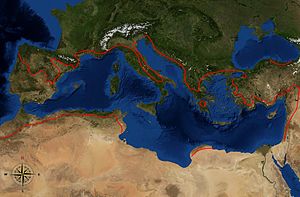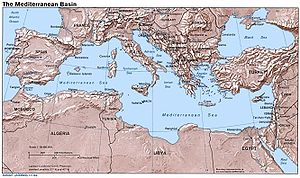- Mediterranean Basin
-
In biogeography, the Mediterranean Basin refers to the lands around the Mediterranean Sea that have a Mediterranean climate, with mild, rainy winters and hot, dry summers, which supports characteristic Mediterranean forests, woodlands, and scrub vegetation. As a rule of thumb, the Mediterranean Basin is the Old World region where olive trees grow.
Contents
Geography
The Mediterranean basin covers portions of three continents, Europe, Asia, and Africa.
Europe lies to the north, and three large Southern European peninsulas, the Iberian Peninsula, Italian Peninsula, and the Balkan Peninsula, extend into the Mediterranean-climate zone. A system of folded mountains, including the Pyrenees dividing Spain from France, the Alps dividing Italy from Central Europe, the Dinaric Alps along the eastern Adriatic, and the Balkan and Rhodope mountains of the Balkan Peninsula divide the Mediterranean from the temperate climate regions of Western and Central Europe.
The Mediterranean Basin extends into Western Asia, covering the western and southern portions of the peninsula of Turkey, excluding the temperate-climate mountains of central Turkey. It includes the Mediterranean climate Levant at the eastern end of the Mediterranean, bounded on the east and south by the Syrian and Negev deserts.
The northern portion of the Maghreb region of northwestern Africa has a Mediterranean climate, separated from the Sahara Desert, which extends across North Africa, by the Atlas Mountains. In the eastern Mediterranean the Sahara extends to the southern shore of the Mediterranean, with the exception of the northern fringe of the peninsula of Cyrenaica in Libya, which has a dry Mediterranean climate.
Geology and paleoclimatology
The Mediterranean Basin was shaped by the ancient collision of the northward-moving African-Arabian continent with the stable Eurasian continent. As Africa-Arabia moved north, it closed the former Tethys Sea, which formerly separated Eurasia from the ancient supercontinent of Gondwana, of which Africa was part. At the same time about 170 mya in the Jurassic, a small Neotethys ocean basin formed shortly before the Tethys Sea was closed at the eastern end. The collision pushed up a vast system of mountains, extending from the Pyrenees in Spain to the Zagros Mountains in Iran. This episode of mountain building, known as the Alpine orogeny, occurred mostly during the Oligocene (34 to 23 million years ago (mya)) and Miocene (23 to 5.3 mya) epochs. The Neotethys became larger during these collisions and associated folding and subduction. About 6 mya during the late Miocene, the Mediterranean was closed at its western end by drifting Arabia, which caused the entire sea to evaporate. The episodes of sea drawdown and reflooding are best known in the Messinian Salinity Crisis, when the Atlantic reflooded the basin at least 69 times.[1]
The end of the Miocene also marked a change in the Mediterranean Basin's climate. Fossil evidence shows that the Mediterranean Basin had a relatively humid subtropical climate with summer rainfall during the Miocene, which supported laurel forests. The shift to a Mediterranean climate occurred within the last 3.2 - 2.8 million years, during the Pliocene epoch, as summer rainfall decreased. The subtropical laurel forests retreated, although they persisted on the islands of Macaronesia off the Atlantic coast of Iberia and North Africa, and the present Mediterranean vegetation evolved, dominated by coniferous trees and sclerophyllous trees and shrubs, with small, hard, waxy leaves that prevent moisture loss in the dry summers. Much of these forests and shrublands have been altered beyond recognition by thousands of years of human habitation. There are now very few relatively intact natural areas in what was once a heavily wooded region.
Flora and fauna
- Main: Category: Environment of the Mediterranean
See also: Category: Plants of Mediterranean climatePhytogeographically, the Mediterranean basin together with the nearby Atlantic coast, the Mediterranean woodlands and forests and Mediterranean dry woodlands and steppe of North Africa, the Black Sea coast of northeasten Anatolia, the southern coast of Crimea between Sevastopol and Feodosia and the Black Sea coast between Anapa and Tuapse in Russia forms the Mediterranean Floristic Region, which belongs to the Tethyan Subkingdom of the Boreal Kingdom and is enclosed between the Circumboreal, Irano-Turanian, Saharo-Arabian and Macaronesian floristic regions.
The Mediterranean Region was first proposed by German botanist August Grisebach in the late 19th century.
Drosophyllaceae, recently segregated from Droseraceae, is the only plant family endemic to the region. Among the endemic plant genera are:
- Tetraclinis
- Rupicapnos
- Ceratocapnos
- Soleirolia
- Ortegia
- Bolanthus
- Lycocarpus
- Ionopsidium
- Bivonaea
- Euzomodendron
- Hutera
- Vella
- Boleum
- Didesmus
- Morisia
- Guiraoa
- Malope
- Drosophyllum
- Ceratonia
- Chronanthus
- Anagyris
- Callicotome
- Spartium
- Hymenocarpus
- Biserrula
- Argania
- Petagnia
- Lagoecia
- Putoria
- Fedia
- Tremastelma
- Bellardia
- Lafuentea
- Rosmarinus
- Argantoniella
- Preslia
- Gyrocarion
- Dorystoechas
- Coridothymus
- Trachelium
- Santolina
- Cladanthus
- Staehelina
- Leuzea
- Andryala
- Rothmaleria
- Chionodoxa
- Hermodactylus
- Triplachne
- Helicodiceros
- Chamaerops
- Aphyllanthes
The genera Aubrieta, Sesamoides, Cynara, Dracunculus, Arisarum and Biarum are nearly endemic. Among the endemic species prominent in the Mediterranean vegetation are the Aleppo Pine, Stone Pine, Mediterranean Cypress, Bay Laurel, Oriental Sweetgum, Holm Oak, Kermes Oak, Strawberry Tree, Greek Strawberry Tree, Mastic, Terebinth, Common Myrtle, Oleander, Acanthus mollis, Vitex agnus-castus. Moreover, many plant taxa are shared with one of the four neighboring floristic regions only. According to different vesions of Armen Takhtajan's delineation, the Mediterranean Region is further subdivided into seven to nine floristic provinces: Southwestern Mediterranean (or Southern Moroccan and Southwestern Mediterranean), Ibero-Balearian (or Iberian and Balearian), Liguro-Tyrrhenian, Adriatic, East Mediterranean, South Mediterranean and Crimeo-Novorossiysk.[2]
The Mediterranean Basin is the largest of the world's five Mediterranean forests, woodlands, and scrub regions. It is home to a number of plant communities, which vary with rainfall, elevation, latitude, and soils.
- Scrublands occur in the driest areas, especially areas near the seacoast where wind and salt spray are frequent. Low, soft-leaved scrublands around the Mediterranean are known as garrigue in France, phrygana in Greece, tomillares in Spain, and batha in Israel.
- Shrublands are dense thickets of evergreen sclerophyll shrubs and small trees, and are the commonest plant community around the Mediterranean. Mediterranean shrublands are known as matorral in Spain, macchia in Italy, and maquis in France, Malta and elsewhere around the Mediterranean. In some places shrublands are the mature vegetation type, and in other places the result of degradation of former forest or woodland by logging or overgrazing, or disturbance by major fires.
- Savannas and grasslands occur around the Mediterranean, usually dominated by annual grasses.
- Woodlands are usually dominated by oak and pine, mixed with other sclerophyll and coniferous trees.
- Forests are distinct from woodlands in having a closed canopy, and occur in the areas of highest rainfall and in riparian zones along rivers and streams where they receive summer water. Mediterranean forests are generally composed of evergreen trees, predominantly oak and pine. At higher elevations Mediterranean forests transition to mixed broadleaf and tall conifer forests similar to temperate zone forests.
The Mediterranean Basin is home to considerable biodiversity, including 22,500 endemic vascular plant species. Conservation International designates the region as a biodiversity hotspot, because of its rich biodiversity and its threatened status. The Mediterranean Basin has an area of 2,085,292 km², of which only 98,009 km² remains undisturbed.
Endangered mammals of the Mediterranean Basin include the Mediterranean Monk Seal, the Barbary Macaque, and the Iberian Lynx.
Ecoregions
- Aegean and Western Turkey sclerophyllous and mixed forests (Greece, Turkey)
- Anatolian conifer and deciduous mixed forests (Turkey)
- Canary Islands dry woodlands and forests (Spain)
- Corsican montane broadleaf and mixed forests (France)
- Crete Mediterranean forests (Greece)
- Cyprus Mediterranean forests (Cyprus)
- Eastern Mediterranean conifer-sclerophyllous-broadleaf forests (Lebanon, Israel, the West Bank, the Gaza Strip, Jordan, Syria, Turkey)
- Iberian conifer forests (Portugal, Spain)
- Iberian sclerophyllous and semi-deciduous forests (Portugal, Spain)
- Illyrian deciduous forests (Albania, Bosnia and Herzegovina, Croatia, Greece, Italy, Slovenia)
- Italian sclerophyllous and semi-deciduous forests (France, Italy)
- Mediterranean acacia-argania dry woodlands and succulent thickets (Morocco, Canary Islands (Spain))
- Mediterranean dry woodlands and steppe (Algeria, Egypt, Libya, Morocco, Tunisia)
- Mediterranean woodlands and forests (Algeria, Morocco, Tunisia)
- Northeastern Spain and Southern France Mediterranean forests (France, Spain)
- Northwest Iberian montane forests (Portugal, Spain)
- Pindus Mountains mixed forests (Albania, Greece, Macedonia)
- South Apennine mixed montane forests (Italy)
- Southeastern Iberian shrubs and woodlands (Spain)
- Southern Anatolian montane conifer and deciduous forests (Lebanon, Israel, Jordan, Syria, Turkey)
- Southwest Iberian Mediterranean sclerophyllous and mixed forests (France, Italy, Morocco, Portugal, Spain)
- Tyrrhenian-Adriatic sclerophyllous and mixed forests (Croatia, France, Italy, Malta)
History
Main article: History of the Mediterranean regionNeanderthals inhabited western Asia and the non-glaciated portions of Europe starting about 230,000 years ago. Modern humans moved into western Asia from Africa less than 100,000 years ago. Modern humans, known as Cro-Magnons, moved into Europe approximately 50-40,000 years ago.
The most recent glacial period, the Wisconsin glaciation, reached its maximum extent approximately 21,000 years ago, and ended approximately 12,000 years ago. A warm period, known as the Holocene climatic optimum, followed the ice age.
Food crops, including wheat, chickpeas, and olives, along with sheep and goats, were domesticated in the eastern Mediterranean in the 9th millennium BCE, which allowed for the establishment of agricultural settlements. Near Eastern crops spread to southeastern Europe in the 7th millennium BCE. Poppy and oats were domesticated in Europe from the 6th to the 3rd millennium BCE. Agricultural settlements spread around the Mediterranean Basin. Megaliths were constructed in Europe from 4500 – 1500 BCE.
A strengthening of the summer monsoon 9000–7000 years ago increased rainfall across the Sahara, which became a grassland, with lakes, rivers, and wetlands. After a period of climatic instability, the Sahara settled into a desert state by the 4th millennium BCE.
Agriculture
Wheat is the dominant grain grown around the Mediterranean Basin. Pulses and vegetables are also grown. The characteristic tree crop is the olive. Figs are another important fruit tree, and citrus, especially lemons, are grown where irrigation is present. Grapes are an important vine crop, grown for fruit and to make wine. Rice and summer vegetables are grown in irrigated areas.
See also
- Life zones of the Mediterranean region
- Mediterranean climate (wine)
- Zanclean flood
References
- ^ W. Krijgsman, A. R. Fortuinb, F. J. Hilgenc and F. J. Sierrod (2001). "Astrochronology for the Messinian Sorbas basin (SE Spain) and orbital (precessional) forcing for evaporite cyclicity". Sedimentary Geology 140: 43. Bibcode 2001SedG..140...43K. doi:10.1016/S0037-0738(00)00171-8.
- ^ Тахтаджян А. Л., Флористические деления суши и океана. Древнесредиземноморское подцарство.
Further reading
- Attenborough, David 1987. The First Eden: the Mediterranean World and Man. Little Brown and Company, Boston.
- Dallman, Peter F. 1998. Plant Life in the World's Mediterranean Climates. California Native Plant Society, University of California Press, Berkeley, California.
- Suc, J-P. (1984). "Origin and evolution of the Mediterranean vegetation and climate in Europe". Nature 307 (5950): 429–428. doi:10.1038/307429a0.
- Wagner, Horst-Günter, Mittelmeerraum, Geography, History, Economy, Wissenschaftliche Buchgesellschaft, Darmstadt 2011, 230 p., [ISBN 978-3-534-23179-9].
External links
- Mediterranean Basin biodiversity hotspot (Conservation International)
- Are wildfires a disaster in the Mediterranean basin? – A review
- MedTrees: Trees and large shrubs of the Mediterranean Basin.
Holarctic Kingdom Circumboreal · Eastern Asiatic · North American Atlantic · Rocky Mountain · Macaronesian · Mediterranean · Saharo-Arabian · Irano-Turanian · MadreanPaleotropical Kingdom Guineo-Congolian · Usambara-Zululand · Sudano-Zambezian · Karoo-Namib · St. Helena and Ascension · Madagascan · Indian · Indochinese · Malesian · Fijian · Polynesian · Hawaiian · NeocaledonianNeotropical Kingdom Caribbean · Guayana Highlands · Amazonian · Brazilian · AndeanSouth African Kingdom Australian Kingdom Northeast Australian · Southwest Australian · Central AustralianAntarctic Kingdom Categories:- Phytogeography
- Floristic regions
- Floristic provinces
- Mediterranean
- Drainage basins of the Mediterranean Sea
- Environment of the Mediterranean
- Mediterranean forests, woodlands, and scrub
- Palearctic
- Biodiversity hotspots
- Natural history of Europe
- North Africa
- Levant
- Mediterranean Basin
Wikimedia Foundation. 2010.


